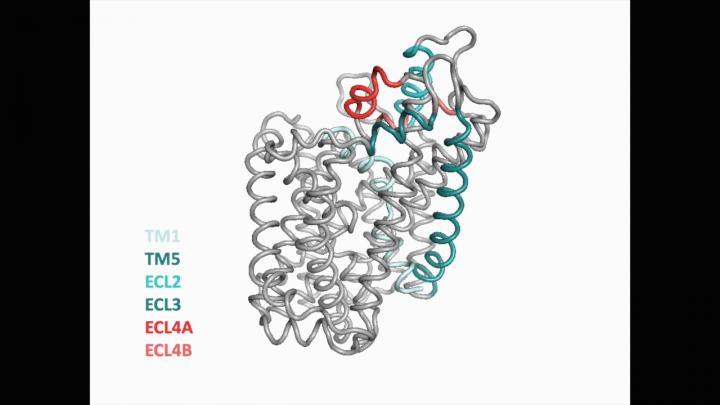
Credit: University of Copenhagen
After five years of experimentation, researchers from the University of Copenhagen have succeeded in crystallising and mapping a novel conformation of LeuT, a bacterial protein that belongs to the same family of proteins as the brain’s so-called neurotransmitter transporters.
These transporters are special proteins that sit in the cell membrane. As a kind of vacuum cleaner, they reuptake some of the neurotransmitters that nerve cells release when sending a signal to one another.
Some drugs or substances work by blocking the transporters, increasing the amount of certain neurotransmitters outside the nerve cells. For example, antidepressants inhibit the reuptake of the neurotransmitter serotonin, while a narcotic such as cocaine inhibits the reuptake of the neurotransmitter dopamine.
‘Transporters are extremely important for regulating the signalling between neurons in the brain and thus the balance of how the whole system works. You cannot do without them’, says Kamil Gotfryd, first author and Associate Professor at the Department of Biomedical Sciences who, during the study, was a postdoc at the Department of Neuroscience.
‘Not only does the new discovery give us additional basic scientific knowledge about the complex transporter proteins. It also has perspectives in relation to developing pharmacological methods, with which we can change the function of transporters. In other words, the discovery may lead to better drugs’, he adds.
From bacteria to human brains
Evolutionary, transporters derive from the most primitive bacteria, which have developed them to absorb nutrients, such as amino acids, from the environment in order to survive.
Since then, specialised transporters have developed to perform a variety of functions. For example, to transport neurotransmitters into neurons in the human brain. Still, the basic principle is the same, namely that the transporter functions by alternately opening and closing to the interior and exterior of a cell, respectively.
When a transporter is open outwardly, it may capture transmitter substances or amino acids. Thereafter, the protein uses sodium ions to change its structure so that it will close outwardly and instead open to the interior of the cell where the transported substance is released and absorbed.
Full cycle
In recent years, X-ray crystallography has enabled researchers to map three stages of the transporter mechanism: Outwardly open, outwardly occluded and inwardly open.
In order for the cycle to be complete, researchers have long concluded that there must also be an inwardly occluded stage of the protein. However, since this structure is unstable, it has long been difficult to freeze it and thus be able to map it.
But now, after many trials, researchers at the University of Copenhagen have succeeded in retaining a transporter for the transmitter leucine – a LeuT – in precisely that stage.
‘We have been working on this for five years, and no matter what we did, we never got the structure we wanted. But suddenly it happened’, says Professor and Head of Department Ulrik Gether of the Department of Neuroscience.
‘Our study is in fact – I would say – ‘the missing link’. This structure has been missing and it has been important to understand the entire cycle which the transporter is going through’, he adds.
A key to more discoveries
Ulrik Gether explains that the key to solving the long-standing mystery was partly a mutation of the transporter and partly a replacement of the substance leucine by the related, but slightly larger phenylalanine molecule.
The combination, so to say, held the transporter long enough in the desired position for researchers to purify, crystallize, and map its structure.
At the same time, Ulrik Gether explains that the high degree of similarity between different types of transporters allows researchers to draw parallels to the transporters of a wide range of other neurotransmitters.
‘Now that we know more about LeuT, the result may be transferred to other transporters of other neurotransmitters. We believe that we can generalise and create better models for, in example, dopamine, serotonin and GABA transporters which are targets for drugs to treat ADHD, depression and epilepsy, respectively’, says Ulrik Gether.
According to the Head of the Department, the next step is to continue working with the transporters found in human nerve cells.
###
Media Contact
Ulrik Gether
[email protected]
45-28-75-75-48
Original Source
https:/
Related Journal Article
http://dx.




